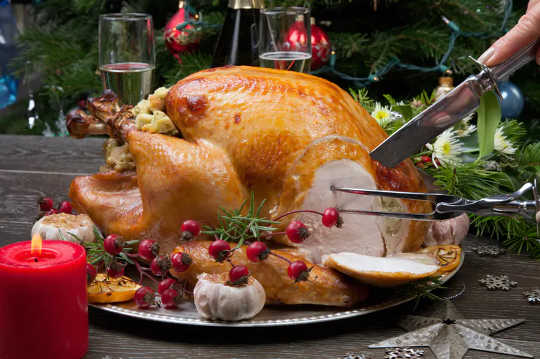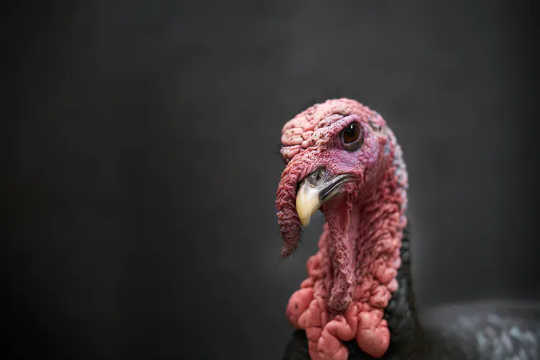
Bochkarev Photography/Shutterstock
Turkey, the traditional festive bird features as number three on the “foods consumed at Christmas” list, after roast potatoes and carrots. Yet not all parts of a turkey are created equal in terms of taste and nutritional goodness. The reason for these difference are found in how turkeys typically move around their environment.
Wild turkeys (Meleagris gallopavo) can fly reasonably short distances, are competent swimmers and have good acceleration and ground speed – a true triathlete! This is in contrast to the turkeys that are farmed for consumption. They are often unable to fly, so their muscle composition and appearance is somewhat different from their wild relative.
What makes a muscle dark?
The muscle protein of any consumed meat is broken down by the digestive system into its principal building blocks: amino acids. The proteins typically consist of three different protein types. The first are myofibrillar proteins, which enable the muscle to contract. Sarcoplasmic proteins include things such as enzymes (which are essential for oxygen metabolism) and myoglobin, which contains the haeme pigment that gives meat its colour. Lastly are collagen proteins, which hold everything together.
As the protein components suggest, myoglobin plays a key role in whether meat is considered dark or white. The myoglobin content is also an indicator of what kind of work the muscle did.
Get The Latest By Email
Dark meat has high levels of myoglobin. It helps bind oxygen in the muscle for use by the mitochondria of the cells, which is essential for making sure the body’s cells function properly. The more the muscle is used, the more myoglobin it needs and the greater blood supply it relies on, thus giving it a darker colour.

Myoglobin is what gives turkey thighs their dark colour. OlegRi/Shutterstock
So, for example, turkeys (and chickens) constantly roam around on the ground, meaning their leg muscles are performing exercise for long periods of time. This is why leg muscles are also known as “slow twitch fibres”, because they’re able to perform for prolonged periods of time without fatigue.
While these muscles have different names in the turkey, they have similar functions as those in human legs (although their knees bend the other way).
The breast and wings, on the other hand, are considered “white” meat. These muscles are rarely used in turkeys (particularly farm-reared turkeys). This means that the breast and wings don’t need to be able to store or use large amounts of oxygen over a prolonged period. These muscles are also known as “fast twitch” fibres, as they are designed for quick bursts of energy but tire quickly. The breast is the same muscle as the pectoralis major muscle in humans.
Which bit is best?
Turkey is leaner, so it has less fat than chicken. Turkey breast has about 160 calories per 84g serving, of which 60 calories come from fat and contains 24g of protein. The remaining calories come from protein and other sources such as blood and collagen in the meat. The wing has 190 calories per 84g serving, of which 90 calories come from fat with 23g of protein. The leg on the other hand has 170 calories per 84g serving, with 70 calories coming from fat and contains 23g of protein.
So as a percentage of calories from protein, the breast is the best. Calories from protein are preferable as they require more energy to breakdown compared to fats or carbohydrates. This process also takes longer and therefore keeps the body feeling fuller for longer.
Dark meat typically has more fat in it, which can be used as an energy store for those long duration activities, such as going for a run. Fat is also the reason the dark meat usually has more flavour. So, if it’s taste you’re after, the leg is best – though the dark meat contains more calories (and fat) than white meat. With this in mind, the underside of the turkey, which acts as the base during cooking, similarly has some of the most flavourful meat. This is because all the fat and juices soak into this dark meat.
Dark meat contains a greater percentage of a person’s recommended daily amount of iron in it. Iron is a vital element in the body. About 70% of it is in your blood and muscles, and it’s important for carrying oxygen round your body. Too little iron can result in anaemia, which can reduce the amount of oxygen that can be carried by haemoglobin causing shortness of breath, tiredness and a lack of energy. So while dark meat might be fattier and higher in calories, it may also have some other benefits over white meat.
About the Author
Adam Taylor, Professor and Director of the Clinical Anatomy Learning Centre, Lancaster University
This article is republished from The Conversation under a Creative Commons license. Read the original article.
books_nutrition










